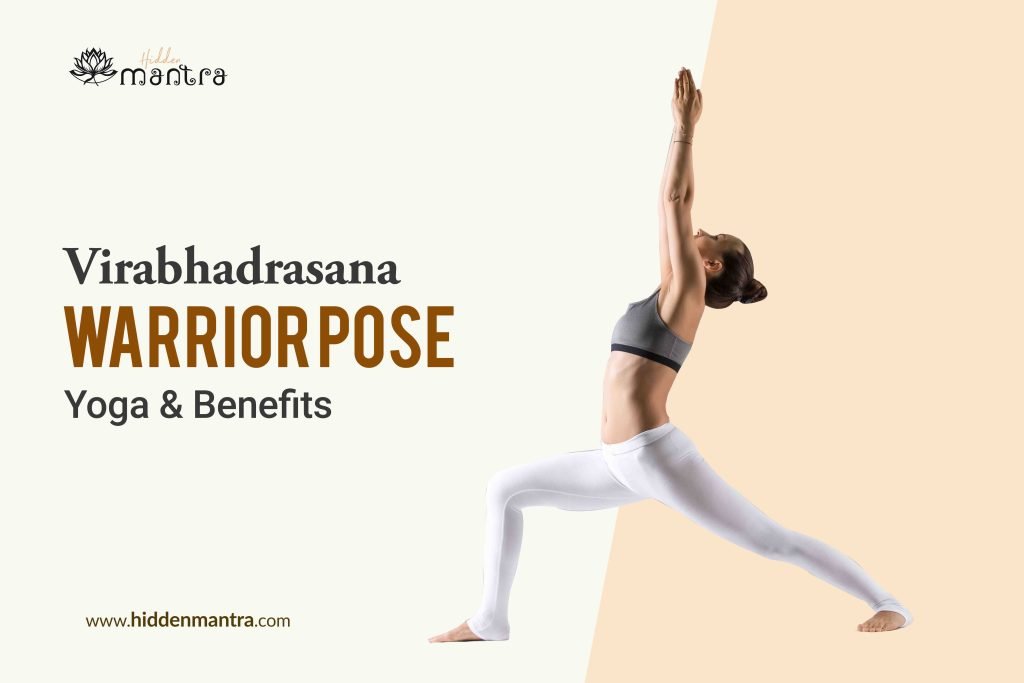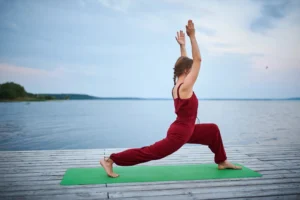Table of Contents
ToggleIntroduction to Virabhadrasana (Warrior Pose)
Warrior Pose, or Virabhadrasana, is a classical yoga move that’s both simple and strong. Imagine standing like a brave warrior, ready for anything. It is a pose for everyone, no matter how young or old you are. Let’s learn more about this powerful and easy-to-do yoga posture.
Virabhadrasana Meaning
The term “Virabhadrasana” is derived from Sanskrit, the ancient language of yoga. Here’s the meaning of “Virabhadrasana” broken down:
Virabhadra
The word “Virabhadra” (वीरभद्र) is composed of two parts:
“Vira” (वीर) means “hero” or “warrior.”
Bhadra
“Bhadra” (भद्र) can be translated as “auspicious,” “blessed,” or “fortunate.”
Asana: The term “Asana” (आसन) means “pose” or “posture.”
So, when you combine these elements, “Virabhadrasana” translates to “Heroic Warrior Pose” or “Auspicious Warrior Pose” in English. This name reflects the strength, courage, and fortitude associated with this yoga pose, making it a symbol of empowerment and determination in the practice of yoga.
Virabhadrasana (Warrior Pose) Yoga Benefits
1. Strong Muscles
- Warrior Pose helps make your leg muscles, like your thighs and calves, strong.
- It also tones your arms, shoulders, and back muscles.
2. Balance and Focus
- This pose needs good balance. Practicing it regularly can make your sense of balance better.
- It helps you concentrate and focus your mind, just like a warrior in battle.
3. Confidence Booster
- Doing Warrior Pose can make you feel strong and confident, just like a warrior!
- It’s a great pose to boost your self-esteem.
4. Better Posture
- Warrior Pose teaches you to stand tall and straight.
- It’s like giving your posture a makeover, making you look and feel more confident.
5. Stress Buster
- Warrior Pose can help calm your mind and reduce stress.
- It’s like a mini-meditation, helping you find peace within yourself.
6. Stretch and Flexibility
- This pose stretches your legs and opens up your hips.
- Over time, it can improve your flexibility and make your body feel more relaxed.
7. Empowerment
- Warrior Pose reminds you of your inner strength and courage.
- It’s like a reminder that you can face any challenge that comes your way.
So, step onto your yoga mat and strike a pose like a warrior. You’ll not only feel stronger but also more confident and focused in your daily life. It’s a simple yet powerful yoga pose that has lots of amazing benefits for your body and mind.
How to Do Virabhadrasana (Warrior Pose)
Step 1 – Start in a Standing Position
Stand up straight at the top of your yoga mat with your feet together.
Step 2 – Step Your Feet Apart
Take a big step back with your left foot. Your feet should be about 3-4 feet apart.
Step 3 – Turn Your Left Foot Outward
Rotate your left foot so it’s pointing to the left side of your mat. Your right foot should still be pointing forward.
Step 4 – Raise Your Arms
Inhale and lift your arms out to the sides until they are parallel to the ground, like aeroplane wings.
Step 5 – Bend Your Right Knee
Exhale and bend your right knee. Your right thigh should be almost parallel to the ground, but make sure your knee doesn’t go past your ankle.
Step 6 – Gaze Ahead
Look over your right hand, keeping your gaze steady.
Step 7 – Hold the Pose
Stay in this strong and stable position for about 15-30 seconds, or as long as feels comfortable. Keep breathing calmly.
Step 8 – Straighten Your Right Leg
To come out of the pose, straighten your right leg and lower your arms.
Step 9 – Repeat on the Other Side
Now, step your right foot back and repeat the pose on your left side.
Virabhadrasana (Warrior Pose) Tips:
- Imagine yourself as a warrior standing strong and confident.
- Keep your upper body relaxed.
- Make sure your knee is directly above your ankle in the bent leg.
- Warrior Pose is a powerful yoga posture that strengthens your legs and brings a sense of empowerment. Practice it regularly to experience its full benefits.
Common Variations of Virabhadrasana (Warrior Pose)
Here are some common variations of Virabhadrasana (Warrior Pose) that you can explore in your yoga practice:
1. Virabhadrasana I (Warrior Pose I)
- The classic Warrior Pose I involves facing forward with your arms reaching overhead and palms together.
- To do it, follow the steps mentioned earlier.
2. Virabhadrasana II (Warrior Pose II)
- In Warrior Pose II, your hips and chest open to the side.
- After stepping your feet apart, extend your arms out to the sides, parallel to the ground.
- Gaze over your front hand (the one pointing forward), keeping your shoulders relaxed.
- This variation emphasizes strength and balance.
3. Virabhadrasana III (Warrior Pose III)
- Warrior Pose III is a balance challenge. Start in Warrior Pose I.
- Shift your weight onto your front leg, and slowly lift your back leg off the ground, keeping your body parallel to the floor.
- Extend your arms forward alongside your ears.
- This variation builds core strength and balance.
4. Reverse Warrior (Viparita Virabhadrasana)
- In this variation, begin in Warrior Pose II.
- Drop your back hand down your back leg and reach your front hand up and back, opening your chest.
- Gaze up toward your raised hand.
- Reverse Warrior provides a deep side stretch and opens up your chest and shoulders.
5. Peaceful Warrior (Shanti Virabhadrasana)
- Start in Warrior Pose II.
- Raise your front arm up, and gently rest your back hand on your back leg.
- Lean back slightly and create a gentle, arching side stretch.
- Peaceful Warrior promotes a sense of openness and peace.
These variations allow you to explore different aspects of Virabhadrasana, from strength and balance to flexibility and openness. Depending on your practice and goals, you can include these variations to add variety and depth to your yoga routine.
Precautions
While Virabhadrasana (Warrior Pose) offers numerous benefits, it’s important to be mindful of certain precautions to practice it safely and effectively. Here are some precautions to keep in mind:
1. Knee Alignment – Ensure that your front knee does not extend beyond your ankle when you bend it. Overextending the knee can strain it. Keep the knee directly above the ankle.
2. Hip Flexibility – If you have hip issues or limited hip flexibility, be cautious when opening your hips in Warrior Pose II. You can modify the pose or use props to support your hips.
3. Balance and Stability – Warrior Pose III, the balancing variation, requires good balance. If you’re new to yoga or have balance concerns, practice near a wall or use a chair for support until you feel confident.
4. Neck Strain – Avoid straining your neck by keeping your gaze neutral or slightly forward, especially in Warrior Pose I and II. Don’t overextend your neck by looking up too much.
5. High Blood Pressure – If you have high blood pressure, be mindful of your breath and don’t hold your breath during the pose. Seek guidance from a yoga instructor or healthcare professional if needed.
6. Recent Injuries – If you have recent injuries or surgeries, especially in the legs, hips, or back, consult with a healthcare provider or experienced yoga instructor before attempting Warrior Pose.
7. Modifications – Don’t hesitate to use props like yoga blocks or a chair for support and balance if needed. There are always ways to modify the pose to suit your current abilities and comfort level.
8. Pain or Discomfort – If you experience sharp or intense pain or discomfort during the pose, ease out of it immediately. Yoga should not cause pain; it should be a comfortable stretch.
Remember that yoga is about respecting your body’s limitations and progressing at your own pace. If you have any underlying health conditions or concerns, it’s a good idea to consult with a healthcare provider or a qualified yoga instructor for personalized guidance.
Conclusion
As we conclude our journey through the world of classical yoga, it’s evident that each yoga pose, from the strength of Warrior Pose to the peace of Shavasana, holds its unique wisdom and benefits. The hidden mantras of these poses whisper the secrets of health and well-being to those who practice them.
So, whether you’re standing tall in Tadasana, reaching for the sky in Uttanasana, or finding balance in Trikonasana, remember that the path to inner peace and physical harmony begins with a single step onto the yoga mat.
For more insights, guidance, and a deeper exploration of these yoga poses, we invite you to visit the Hidden Mantra blog on our website. There, you’ll discover a wealth of knowledge and inspiration to support your yoga journey.
As you continue to embrace the practice of yoga, may the hidden mantras within each pose guide you toward a healthier, more balanced, and harmonious life. Namaste!









